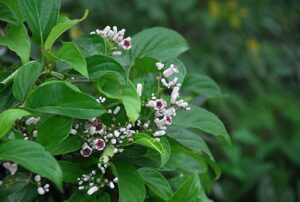Unveiling the Therapeutic Potential of Paederia scandens(Bhedailota) in Livestock and Poultry

Paederia scandens
Abstract: Paederia scandens, a medicinal plant with traditional use in various cultures, has garnered attention for its potential therapeutic properties in veterinary medicine. Here in this article i have written about the efficacy of Paederia scandens in treating two prevalent conditions in livestock and poultry.splenomegaly and fatty liver.
Introduction:
Fatty liver disease, a common metabolic disorder in chickens, poses significant economic challenges to the poultry industry. Studies investigating the effects of Paederia scandens extract on fatty liver in chickens have shown promising results, indicating its potential as a natural remedy for this condition. The plant’s antioxidant and anti-inflammatory properties may contribute to its hepatoprotective effects.
Splenomegaly, characterized by an enlarged spleen, is a multifactorial condition affecting cattle health and productivity. While scientific evidence on the direct efficacy of Paederia scandens in treating splenomegaly in cattle is limited, traditional knowledge and anecdotal reports suggest its use in alleviating symptoms associated with this condition. Further studies are warranted to elucidate the mechanisms of action and optimize dosage regimens for effective management of splenomegaly in cattle.
Plant profile:
Paederia scandens, commonly known as Chinese fever vine or skunk vine( local name Bhedailota), is a wild edible plant of Assam that belongs to the Rubiaceae family. Here are some key morphology characteristics of Paederia scandens:
Habit: Paederia scandens is a perennial climbing vine with long, slender stems that can grow up to several meters in length. It climbs using tendrils and may form dense thickets.
Leaves: The leaves are opposite, simple, and elliptic to ovate in shape, with entire margins. They are typically dark green and glossy, measuring 5-12 cm in length and 2.5-6 cm in width.
Inflorescence: The flowers are small, tubular, and arranged in clusters at the leaf axils. The inflorescence is typically cymose, with flowers having a strong, unpleasant odor, hence the common name “skunk vine.”
Flowers: Each flower has a tubular corolla with five lobes, usually pale pink to lavender in color. They are often inconspicuous among the foliage.
Fruits: The fruit is a small, spherical berry, initially green but turning black when ripe. It contains numerous seeds.
Roots: Paederia scandens has a fibrous root system.
Stem: The stems are woody at the base and herbaceous towards the tips, often becoming ligneous with age.
Growth Habit: As a climbing vine, Paederia scandens exhibits a twining growth habit, using tendrils to cling onto nearby structures for support as it climbs.
Pharmacological properties of P.scandens:
Anti-inflammatory: In 1973 Srivastava et al and Ma et al found that Paederia has strong anti-inflammatory properties. Different parts of the plant, such as the leaves and extracts, have been shown to reduce inflammation effectively. In traditional medicine, it’s used to treat joint diseases like rheumatoid arthritis, with methods ranging from applying leaf paste externally to consuming plant extracts internally. Research also suggests that extracts of Paederia scandens, another related plant, can reduce inflammation in conditions like acute gouty arthritis by inhibiting joint swelling and improving mobility in rats. These effects are believed to be mediated by reducing levels of inflammatory markers like TNF-α and IL-1β. Overall, these findings indicate the potential of Paederia plants as natural remedies for managing inflammatory conditions.
Digestive aid: It’s believed to have digestive properties and may be used to relieve gastrointestinal discomfort in animals. studies have found that the plant has healing properties for digestive issues. People in India use a decoction made from its leaves and shoots to treat abdominal pain and gastric ulcers, and a decoction from the root to expel worms. In Assam, the plant’s aerial parts are used to cure diarrhea and dysentery, with the leaf extract showing anti-ulcer and anti-inflammatory effects. Research made by Afroz et al in 2006 in mice found that Paederia foetida has the ability to reduce diarrhea when administered orally.
Antimicrobial:. Research has shown that Paederia scandens, when prepared as a decoction or injection, has the potential to fight against harmful bacteria like Staphylococcus aureus, Shigella flexneri, and Escherichia coli. In 2005 ,Wang et al studied and found that paederia has strong effect against Helicobacter pylori, a bacteria that can cause stomach ulcers. Additionally, Paederia scandens may help prevent bacterial resistance by inhibiting enzymes that contribute to it. Moreover, the plant’s volatile oil, extracted using steam distillation, has demonstrated significant antiviral properties, particularly against hepatitis B virus. These findings suggest that Paederia scandens could be a valuable natural remedy for combating bacterial and viral infections.
Antioxident property:Studies found that fresh Paederia foetida showed the highest antioxidant activity, almost as good as DL-α-tocopherol, a form of vitamin E known for its antioxidant effects. The antioxidant activity was lower in dried samples compared to fresh ones, likely because fresh samples had higher amounts of phenolic compounds, which contribute to antioxidant effects.
Methods
1.Paederia scandens samples were harvested and subjected to hydro-distillation to obtain essential oil. Then through High-performance liquid chromatography (HPLC) key constituents of the oil, including linalool, terpineol, methyl salicylate, camphor, borneol, eugenol, and isoeugenol are identified . A chicken NAFLD model was established through high-capacity diet induction, followed by treatment with Paederia scandens essential oil. Proteomics analysis was conducted to investigate hepatic ROS, MDA levels, and differential protein expression, focusing on the central regulator HSP7C and its protein interactions.
2.According to survey made in karbi village in Gohpur,Assam.Leaf juice is given to animal to treat splenmegaly.Also the paste of the leaf is used treating wounds.Increase appetite and tocure stomach problems.
Acknowledgement
I would like to express my sincerest gratitude to Dr.Biju Borah, PhD Assistant Professor ,Department of Veterinary and Animal Husbandry Extension Education,Lakhimpur College of Veterinary Science for giving me the opportunity to write an article on above topic. Your support and encouragement have truly inspired me to explore and express my thoughts on the chosen topic
Writer
Zafar ansari
Third professional year, BVSc & AH
Lakhimpur College of Veterinary Science
Joyhing, North lakhimpur
References :
https://images.app.goo.gl/CwaabJffQbEGDpsP9


